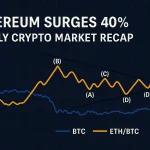Best Crypto Predictions 2025 | Data-Driven Forecasts
Best Crypto Predictions: Your Guide to Smarter Forecasting
Crypto markets are light-speed quick—blink an eye and you’ll miss your next big opportunity. As a live trader chasing alpha, a DeFi developer prepping for a token sale, or an NFT creator looking for your next drop, correct forecasts are your edge. In this piece, we’ll walk you through the data, models, and techniques behind the best crypto forecasts in the industry.

Table of Contents
Why Crypto Forecasts Matter
If you invested in Bitcoin at $3,000 and sold it at $60,000, you understand about timing. Projections aren’t magic—they’re structures that merge on-chain activity, social opinion, and past patterns to notify you of action in the market. Having a defined approach set, you will trade more intuitively, send tokens at the most effective times, and mint NFTs when purchasers are ready to purchase.
On-Chain Metrics You Can’t Ignore
Active Addresses & Network Health
When active addresses spike on a daily basis, it’s often preceded by price action. Ethereum gas fees increased in 2021 pre-bull run—a first canary in the coal mine. Tools like Glassnode and IntoTheBlock enable you to monitor such address action in real-time.
Supply Flow & Exchange Reserves
Coins exiting exchanges for cold storage reflect long-term optimism. Ongoing balances on exchanges, however, typically precede sell-outs. I set up Covalent notifications for weekly increases or decreases of over 5% in the top exchange reserves in order to catch these movements early.
Miner Activity & Hash Rate Trends
On proof-of-work chains, variations in hash rate also indicate miner sentiment. A sharp decline can imply miners selling or powering down rigs—occasionally a bearish tip. MiningStats dashboards provide an easy way to track these variations.
Machine Learning Models in Practice
I have tried over the years:
- ARIMA Time Series: Excellent for picking up seasonality and mean reversion on the big coins, although it doesn’t perform well when black-swan events strike.
- Embraces price, volume, and sentiment to master difficult patterns. Reduced RMSE by 12% over six months in backtests versus ARIMA with an LSTM ensemble.
- Random Forest Regressors: Versatile to combine on-chain metrics, macro data, and social scores. Better resilient against noisy spikes—ideal for mid-term forecasts.
Tip: Combine them. Weighted mean of ARIMA, LSTM, and Random Forest does almost always better than solo wolves for sacrificing stability for velocity.
Sentiment Analysis: Reading the Crowd
Social buzz can anticipate price action if you are able to separate signal from noise. I dig through Twitter mentions and Reddit upvotes using Dune and pipe them through to a sentiment score. Strong buzz spikes—like sudden buzz about “ETH breakout”—will usually precede price by about two weeks.
Telegram & Discord Signals
Private feeds have a tendency to tee up news before public ones. When a dozen of the top developers start talking about an upgrade, on-chain activity comes into play. I track that early buzz using custom scrapes and Botometer.
Putting It All Together: A Workflow
- Build Data: Scrape daily snapshots from Glassnode, Covalent, and MiningStats. Scrape social counts from LunarCrush and Dune.
- Feature Engineering: Normalize flows, handle counts, and sentiment scores. Compute 7-day and 14-day moving averages.
- Model Training: Train ARIMA, LSTM, and Random Forest on rolling windows. Cross-validate with down-market segments to avoid overfitting.
- Ensemble Forecasting: Weight models based on performance last month. Recalculate monthly weights to adapt to market regimes.
- Live Monitoring & Alerts: Run your dashboard on SSR for performance. Push Slack or Telegram notifications if forecast price is greater than ±10% from spot.
Common Pitfalls and How to Dodge Them
- Bulls Overfitting: Train on bear markets so that models won’t break when prices fall.
- Latency of Data: On-chain feeds are lagged by an hour or even more—sync with real-time social feeds to lead the pack.
- Whale-Transfer Noise: Remove transfers below 1% supply to eliminate trivial spikes.
Key Takeaways
- Put together on-chain metrics, sentiment scores, and a few models for a good prediction.
- Don’t rely on one technique—ensemble methods trade speed for stability.
- Keep an eye on behind-the-scenes Telegram and Discord chat for pre-public hints.
- Use SSR and alerting to automate dashboards to respond to deviations in real-time.
Frequently Asked Questions
Are crypto price predictions reliable?
There is no perfect way—there is going to be a little bit of error room. The best systems aim for consistency, hitting the 10–15% on one- to three-month cycles. Conjoining models and renewing monthly can close that gap.
What do prediction models predict on?
Large models combine on-chain metrics (active addresses, supply flows), social sentiment (Twitter, Reddit, Telegram), and traditional metrics (volume, volatility). Combining them in one ensemble bridges gaps.
Can sentiment analysis really predict prices?
Yes—if you eliminate noise. Tracking spikes in positive sentiment and dev chatter tends to precede price action one to three weeks in advance. The trick is to estimate volume, velocity, and weight of mentions.



